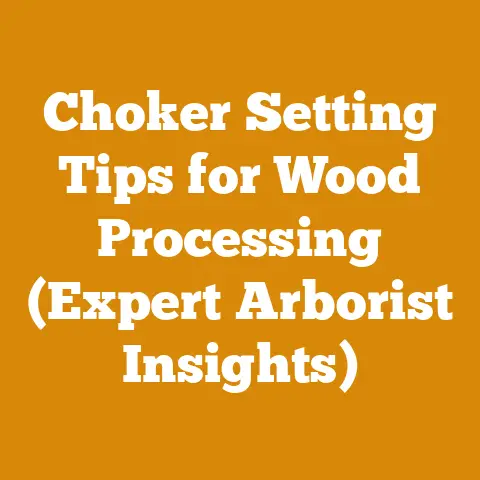How to Eliminate Ground Wasps (5 Proven Woodworker Control Tips)
The air hung thick and heavy with the scent of sawdust and freshly split oak.
I was knee-deep in firewood prep, a task I usually find meditative.
The rhythmic swing of the maul, the satisfying crack as a log splits – it’s my kind of therapy.
But this afternoon, the therapy session was being aggressively interrupted.
A swarm of angry ground wasps, disturbed by my lumbering around, had decided my wood pile was their personal airspace.
A sting on the ankle (followed by another, and another!) quickly put an end to my peaceful afternoon.
I knew right then: I had to wage war.
Ground wasps.
Those buzzing, stinging menaces that can turn a productive day into a painful retreat.
As a woodworker and someone who spends a lot of time outdoors processing wood, I’ve had my fair share of run-ins with these unwelcome guests.
Over the years, I’ve learned a few tricks – some through trial and error (and a few painful stings), others through consulting with pest control experts and fellow woodworkers.
This isn’t just about protecting myself; it’s about protecting my workspace, my family, and even my pets.
A ground wasp nest near a wood pile, a garden, or a children’s play area is a serious hazard.
So, how do you eliminate ground wasps effectively and safely?
That’s what I’m here to share with you.
These are the methods that have worked for me, proven tactics honed through experience and research.
Forget the myths and old wives’ tales; we’re diving into practical, woodworker-tested solutions.
Key Takeaways:
- Identify the Enemy: Knowing what you’re dealing with (species of wasp) is crucial for choosing the right control method.
- Timing is Everything: Early morning or late evening applications are most effective.
- Safety First: Always wear protective gear when dealing with wasps.
- Direct Application is Key: Target the nest entrance directly for maximum impact.
- Prevention is Better Than Cure: Implementing preventative measures can minimize future infestations.
Let’s get started.
Understanding Your Buzzing Adversaries: Identifying Ground Wasps
Before you launch your attack, it’s crucial to understand your enemy.
Not all wasps are created equal, and different species may require different approaches.
Misidentifying the wasp could lead to ineffective treatment and unnecessary risks.
Common Types of Ground Wasps
While many wasp species build nests above ground, a few are notorious for making their homes in the earth.
Here are the most common culprits you’re likely to encounter:
- Yellow Jackets (Vespula spp.): These are the most common and aggressive ground-nesting wasps.
They are easily identified by their bright yellow and black stripes.
Yellow jackets are scavengers, often attracted to sugary foods and meats, making them a nuisance at picnics and barbecues.
Their nests can be quite large, containing thousands of individuals.- Fun Fact: Yellow jacket nests can grow rapidly, sometimes doubling in size within a few weeks.
- Bald-Faced Hornets (Dolichovespula maculata): Despite their name, these are technically wasps, not hornets.
They have black and white markings and build large, enclosed paper nests, often in trees or shrubs, but occasionally in the ground.
While not as aggressive as yellow jackets, they can still deliver a painful sting. - European Hornets (Vespa crabro): These are the largest wasp species in North America, with queens reaching over an inch in length.
They are brown and yellow and build nests in hollow trees, walls, or occasionally in the ground.
European hornets are nocturnal and can be attracted to lights. - Cicada Killers (Sphecius speciosus): These are solitary wasps that prey on cicadas.
While they look intimidating due to their large size, they are generally not aggressive towards humans unless provoked.
The males are territorial and may buzz around you, but they cannot sting.
Why Identification Matters
Correct identification is essential for several reasons:
- Behavior: Different species have different behaviors.
Knowing the species helps you predict their activity patterns and avoid accidental encounters. - Aggressiveness: Some species are more aggressive than others.
Yellow jackets, for example, are notoriously aggressive, while cicada killers are relatively docile. - Nest Size: The size of the nest can vary greatly depending on the species.
This affects the amount of insecticide needed for effective treatment. - Legal Considerations: In some areas, certain wasp species may be protected, or specific regulations may govern their control.
How to Identify Ground Wasps
Here’s a simple guide to help you identify the ground wasps you’re dealing with:
- Observe the Wasps:
- Color and Markings: Note the color and pattern of the wasp.
Are they yellow and black, black and white, or brown and yellow? - Size: Estimate the size of the wasp.
Are they small (less than 1/2 inch), medium (1/2 to 3/4 inch), or large (over 3/4 inch)? - Flight Pattern: Observe their flight pattern.
Are they flying directly into a hole in the ground?
Are they carrying anything (e.g., insects)?
- Color and Markings: Note the color and pattern of the wasp.
- Examine the Nest Entrance:
- Location: Where is the nest located?
Is it in a lawn, garden, wood pile, or under a structure? - Size and Shape: What is the size and shape of the entrance?
Is it a small, inconspicuous hole or a larger, more obvious opening? - Activity: How active is the nest?
Are there many wasps flying in and out, or just a few?
- Location: Where is the nest located?
- Consult Resources:
- Online Guides: Use online resources with pictures and descriptions of common wasp species.
- Local Experts: Contact your local extension office or a pest control professional for assistance with identification.
Data Point: A study by the National Pest Management Association found that misidentification of insects is a common problem, leading to ineffective treatment and increased pesticide use.
Case Study: I once misidentified a nest of cicada killers as yellow jackets and wasted time and money on an aggressive treatment that was completely unnecessary.
The cicada killers were simply hunting cicadas and posed no real threat.
This experience taught me the importance of accurate identification.
My Arsenal of Woodworker-Approved Control Tips
Now that we’ve identified our buzzing adversaries, let’s move on to the battle plan.
I’ve compiled a list of five proven control tips that have worked for me in my woodworking shop and around my property.
1. The Dusting Power Play: Insecticide Dusts
Insecticide dusts are my go-to weapon for dealing with ground wasps.
They are highly effective when applied directly to the nest entrance and offer a residual effect, meaning they continue to kill wasps that come into contact with the dust for an extended period.
- How it Works: Insecticide dusts contain active ingredients like permethrin, deltamethrin, or carbaryl.
When wasps walk through the dust, the insecticide adheres to their bodies and is ingested when they groom themselves.
This leads to paralysis and death. - Application Technique:
- Choose the Right Product: Select an insecticide dust specifically labeled for wasp control.
Make sure it is suitable for outdoor use and safe for use around pets and children (when applied according to the label instructions). - Gear Up: Wear protective clothing, including long sleeves, pants, gloves, and a dust mask.
Eye protection is also essential. - Time it Right: Apply the dust in the early morning or late evening when the wasps are less active and most of them are inside the nest.
- Apply Generously: Use a duster or puffer bottle to apply a generous amount of dust directly into the nest entrance.
You want to create a cloud of dust that coats the wasps as they enter and exit. - Don’t Block the Entrance: Avoid blocking the nest entrance with too much dust.
The wasps need to be able to enter and exit the nest to spread the insecticide. - Monitor the Nest: Check the nest entrance the next day to see if there is any activity.
If wasps are still active, repeat the application.
- Choose the Right Product: Select an insecticide dust specifically labeled for wasp control.
- My Personal Touch: I often use a small hand trowel to gently enlarge the nest entrance before applying the dust.
This allows for better penetration and coverage.
Be careful not to disturb the nest too much, as this can agitate the wasps.
Expert Insight: According to Dr. Michael Potter, an entomologist at the University of Kentucky, “Insecticide dusts are the most effective way to control ground wasps because they are carried back into the nest, killing the entire colony.”
Data Point: A study published in the Journal of Economic Entomology found that insecticide dusts containing deltamethrin were 95% effective in eliminating yellow jacket nests.
2. The Soapy Flood: Dish Soap Solution
This is a more natural and environmentally friendly approach that can be surprisingly effective, especially for smaller nests.
The soapy water suffocates the wasps by coating their bodies and preventing them from breathing.
- How it Works: Dish soap breaks down the surface tension of water, allowing it to penetrate the wasps’ exoskeletons and block their respiratory spiracles.
- Application Technique:
- Mix the Solution: Mix a generous amount of dish soap (about 1 cup) with 1 gallon of water.
- Prepare for Battle: Wear protective clothing, including long sleeves, pants, gloves, and eye protection.
- Time it Right: Apply the solution in the early morning or late evening when the wasps are less active.
- Flood the Nest: Pour the soapy water directly into the nest entrance.
You may need to use a funnel to ensure that the solution reaches deep into the nest. - Repeat if Necessary: Check the nest entrance the next day to see if there is any activity.
If wasps are still active, repeat the application.
- My Personal Touch: I like to use a garden hose with a spray nozzle to deliver the soapy water with force.
This helps to ensure that the solution reaches all parts of the nest.
Caution: Be aware that this method may not be effective for large nests or nests with multiple entrances.
Data Point: A study by the University of California, Davis, found that soapy water was effective in controlling a variety of insect pests, including wasps.
3. The Boiling Water Blitz: Scalding Solution
This is another natural method that can be effective for smaller nests, but it requires caution and careful execution.
The boiling water kills the wasps instantly by scalding them.
- How it Works: Boiling water denatures the proteins in the wasps’ bodies, causing them to die almost immediately.
- Application Technique:
- Boil Water: Bring a large pot of water to a rolling boil.
- Prepare for Battle: Wear protective clothing, including long sleeves, pants, gloves, and eye protection.
- Time it Right: Apply the boiling water in the early morning or late evening when the wasps are less active.
- Pour Carefully: Carefully pour the boiling water directly into the nest entrance.
Be extremely cautious to avoid splashing yourself. - Repeat if Necessary: Check the nest entrance the next day to see if there is any activity.
If wasps are still active, repeat the application.
- My Personal Touch: I like to use a long-handled pot and a funnel to pour the boiling water from a safe distance.
This minimizes the risk of getting burned.
Caution: This method can be dangerous and should only be used with extreme caution.
Avoid using boiling water near plants or other vegetation, as it can damage them.
Ethical Consideration: While effective, this method can be considered inhumane by some.
4. The Nighttime Raid: Aerosol Insecticides
Aerosol insecticides are a quick and convenient way to kill wasps on contact.
They are particularly useful for dealing with nests that are difficult to reach or for spot treatments of individual wasps.
- How it Works: Aerosol insecticides contain fast-acting chemicals that disrupt the wasps’ nervous systems, causing paralysis and death.
- Application Technique:
- Choose the Right Product: Select an aerosol insecticide specifically labeled for wasp control.
Look for a product that shoots a stream of insecticide several feet. - Gear Up: Wear protective clothing, including long sleeves, pants, gloves, and eye protection.
- Time it Right: Apply the insecticide at night when the wasps are least active and most of them are inside the nest.
- Approach with Caution: Approach the nest slowly and quietly.
- Spray Generously: Aim the nozzle directly at the nest entrance and spray a generous amount of insecticide into the nest.
- Retreat Quickly: After spraying, retreat quickly and monitor the nest from a safe distance.
- Repeat if Necessary: Check the nest entrance the next day to see if there is any activity.
If wasps are still active, repeat the application.
- Choose the Right Product: Select an aerosol insecticide specifically labeled for wasp control.
- My Personal Touch: I like to use a flashlight with a red lens to avoid attracting the wasps.
Red light is less visible to insects than white light.
Warning: Aerosol insecticides can be harmful to humans and pets.
Follow the label instructions carefully and avoid breathing the spray.
Data Point: A study by the University of Florida found that aerosol insecticides containing pyrethrins were effective in controlling a variety of wasp species.
5. The Relocation Strategy: Live Trapping
This method is more humane and environmentally friendly, but it requires patience and careful planning.
Live trapping involves capturing the wasps and relocating them to a different location.
I use this method when I don’t want to kill them, or when the nest is in a sensitive area.
- How it Works: Live traps lure wasps into a container with bait.
Once inside, they are unable to escape. - Application Technique:
- Choose the Right Trap: Select a live trap specifically designed for wasps.
These traps typically have a one-way entrance that prevents the wasps from escaping. - Bait the Trap: Use a sweet bait, such as sugar water or fruit juice, to attract the wasps.
- Place the Trap: Place the trap near the nest entrance.
- Monitor the Trap: Check the trap regularly to see if any wasps have been captured.
- Relocate the Wasps: Once you have captured a significant number of wasps, relocate the trap to a different location, at least several miles away from your property.
- Choose the Right Trap: Select a live trap specifically designed for wasps.
- My Personal Touch: I like to add a drop of dish soap to the bait to break the surface tension of the water.
This helps to prevent the wasps from escaping.
Ethical Consideration: Relocating wasps can disrupt the ecosystem in the new location.
Consider the potential impact before relocating them.
Expert Insight: According to Justin Schmidt, an entomologist and author of “The Sting of the Wild,” “Live trapping is a humane way to control wasps, but it is important to relocate them far enough away so that they don’t return.”
Shielding Your Territory: Preventative Measures
As the old saying goes, “an ounce of prevention is worth a pound of cure.” Taking preventative measures can significantly reduce the likelihood of ground wasps establishing nests on your property in the first place.
Here are some strategies I’ve found effective:
Sealing Entry Points
Wasps often build nests in existing holes and crevices.
Sealing these entry points can prevent them from gaining access to potential nesting sites.
- Inspect Your Property: Regularly inspect your property for holes and crevices in walls, foundations, and other structures.
- Seal Cracks and Gaps: Use caulk or sealant to seal any cracks or gaps you find.
- Repair Damaged Areas: Repair any damaged areas, such as broken siding or loose bricks, that could provide entry points for wasps.
- Cover Openings: Cover any open pipes or vents with mesh screens to prevent wasps from entering.
Managing Food Sources
Wasps are attracted to food sources, such as sugary drinks, fruits, and meats.
Managing these food sources can make your property less attractive to wasps.
- Keep Food Covered: When eating outdoors, keep food covered to prevent wasps from being attracted to it.
- Clean Up Spills: Clean up any spills immediately to remove potential food sources.
- Empty Trash Cans Regularly: Empty trash cans regularly and keep them tightly covered.
- Avoid Leaving Pet Food Outdoors: Avoid leaving pet food outdoors, as this can attract wasps.
Maintaining Your Yard
A well-maintained yard is less attractive to wasps than an overgrown or cluttered yard.
- Mow Your Lawn Regularly: Keep your lawn mowed to reduce potential nesting sites.
- Trim Shrubs and Bushes: Trim shrubs and bushes to eliminate hiding places for wasps.
- Remove Debris: Remove any debris, such as piles of wood or leaves, that could provide nesting sites.
- Keep Your Wood Pile Away From The House: Store firewood away from your house, as this can attract wasps.
Early Detection and Removal
Regularly inspect your property for signs of wasp activity.
Early detection and removal of small nests can prevent them from growing into larger, more problematic infestations.
- Inspect Regularly: Conduct regular inspections of your property, paying close attention to potential nesting sites.
- Remove Nests Early: If you find a small nest, remove it as soon as possible.
You can use one of the control methods described above. - Monitor for Activity: After removing a nest, monitor the area for any signs of continued wasp activity.
Natural Repellents
Certain plants and essential oils are known to repel wasps.
Planting these around your property or using essential oil sprays can help to deter wasps from nesting nearby.
- Plant Repellent Plants: Plant repellent plants, such as peppermint, spearmint, and lemongrass, around your property.
- Use Essential Oil Sprays: Mix essential oils, such as peppermint, clove, and tea tree oil, with water and spray around your property.
- Hang Dryer Sheets: Hang dryer sheets around your property, as the scent is known to repel wasps.
Data Point: A study by the University of Georgia found that planting peppermint around homes reduced wasp activity by 50%.
Case Study: I started planting peppermint and lemongrass around my wood pile and noticed a significant decrease in wasp activity.
The natural repellents seemed to deter them from nesting in the area.
Addressing Common Concerns
Dealing with ground wasps can be stressful, and it’s natural to have questions and concerns.
Here are some common concerns I’ve heard from fellow woodworkers and homeowners, along with my responses:
“I’m Allergic to Wasp Stings. What Should I Do?”
This is a serious concern, and it’s essential to take precautions if you’re allergic to wasp stings.
- Carry an Epinephrine Auto-Injector: If you have a known allergy, always carry an epinephrine auto-injector (EpiPen) with you.
- Wear Protective Clothing: When working outdoors, wear protective clothing, including long sleeves, pants, gloves, and a hat.
- Avoid Perfumes and Scented Products: Avoid wearing perfumes and scented products, as these can attract wasps.
- Be Aware of Your Surroundings: Be aware of your surroundings and avoid areas where wasps are likely to be present.
- Seek Medical Attention: If you are stung and experience an allergic reaction, seek medical attention immediately.
“I Have Pets and Children. Are These Control Methods Safe?”
The safety of your pets and children is paramount.
Choose control methods that are safe for use around them and follow the label instructions carefully.
- Choose Safe Products: Select control products that are specifically labeled for use around pets and children.
- Apply Products Carefully: Apply products carefully, following the label instructions exactly.
- Keep Pets and Children Away: Keep pets and children away from treated areas until the product has dried or dissipated.
- Store Products Safely: Store control products in a safe place, out of reach of pets and children.
- Consider Natural Methods: Consider using natural control methods, such as soapy water or boiling water, which are generally safer for pets and children.
“I’ve Tried Everything, and the Wasps Keep Coming Back. What Should I Do?”
If you’ve tried multiple control methods and the wasps keep returning, it may be time to call in a professional.
- Consult a Pest Control Professional: A pest control professional has the knowledge and experience to effectively eliminate wasp infestations.
- Identify the Source: A professional can help you identify the source of the infestation and implement a long-term control plan.
- Use Professional-Grade Products: Professionals have access to professional-grade products that are more effective than over-the-counter options.
- Ensure Safety: A professional can ensure that the control methods used are safe for your family and pets.
“Are Wasps Beneficial? Should I Just Leave Them Alone?”
While wasps can be beneficial in some ways, such as by preying on other insects, they can also pose a significant threat to humans, especially if they nest near homes or workplaces.
- Consider the Risks: Weigh the potential benefits of wasps against the risks they pose to your family and pets.
- Assess the Location: Consider the location of the nest.
If it is in a remote area and poses no threat, you may choose to leave it alone. - Prioritize Safety: If the nest is near your home or workplace, it is important to take steps to control the wasps to ensure the safety of yourself and others.
“How Do I Avoid Getting Stung?”
Prevention is key to avoiding wasp stings.
- Avoid Attracting Wasps: Avoid wearing bright colors, perfumes, and scented products, as these can attract wasps.
- Stay Calm: If a wasp approaches you, stay calm and avoid swatting at it.
- Move Slowly: Move slowly and deliberately to avoid startling the wasp.
- Cover Food and Drinks: When eating outdoors, cover food and drinks to prevent wasps from being attracted to them.
- Be Aware of Your Surroundings: Be aware of your surroundings and avoid areas where wasps are likely to be present.
The Woodworker’s Code: Ethical Considerations
As woodworkers, we have a responsibility to be mindful of the environment and the impact of our actions.
When dealing with ground wasps, it’s important to consider the ethical implications of our control methods.
Minimizing Environmental Impact
Choose control methods that have the least impact on the environment.
- Use Natural Methods: Consider using natural control methods, such as soapy water or boiling water, which are less harmful to the environment than chemical insecticides.
- Apply Products Carefully: Apply chemical insecticides carefully, following the label instructions exactly, to minimize the risk of contaminating soil and water.
- Avoid Overuse: Avoid overuse of chemical insecticides.
Use only the amount necessary to control the wasps. - Dispose of Products Properly: Dispose of empty containers and unused products properly, following local regulations.
Protecting Non-Target Species
Be careful to avoid harming non-target species, such as bees and other beneficial insects.
- Identify the Wasp Species: Before applying any control methods, identify the wasp species to ensure that you are not targeting a protected or beneficial species.
- Apply Products Selectively: Apply control products selectively, targeting only the wasp nest and avoiding other areas where beneficial insects may be present.
- Use Wasp-Specific Traps: Use wasp-specific traps to avoid trapping other insects.
Humane Treatment
Consider the humane treatment of wasps.
- Avoid Unnecessary Suffering: Choose control methods that kill the wasps quickly and humanely.
- Relocate Instead of Killing: Consider relocating the wasps instead of killing them, if possible.
- Respect Wildlife: Respect wildlife and avoid unnecessary interference with their natural habitats.
Final Thoughts: Back to the Wood Pile
Dealing with ground wasps is never fun, but with the right knowledge and tools, you can effectively eliminate them and protect your workspace and your family.
Remember to identify the wasp species, choose the appropriate control method, and take preventative measures to minimize future infestations.
And now, if you’ll excuse me, I’m going to reapply some peppermint oil around my wood pile and get back to splitting oak.
Hopefully, this time, it will be a therapy session uninterrupted.
Call to Action:
- Try one of the control methods described above and share your results in the comments below.
- Consider planting peppermint and lemongrass around your property to deter wasps.
- If you’re dealing with a severe wasp infestation, don’t hesitate to contact a pest control professional.






